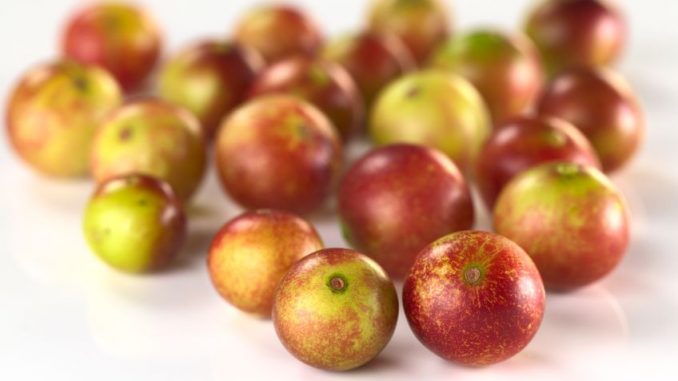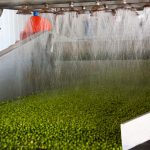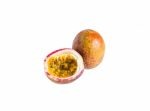
There are some fascinating fruits to be found in the South American jungles and none more so than the fruit of the camu camu (Myrciaria dubia (HBK) Family: Myrtacea (McVaugh 1963). It is known by a number of other names including guavaberry, rumberry, mirto, cabo de chivo and merisier-cerise.
It is a small tree which can reach 9 metres, found native to the Amazon basin, in the wetlands and produces fruit as a round (globosa) berry (av. 2-5cm in diameter) with upto three seeds. The colour of the fruit is red to violet/purple which is described by some as nearly a peel. It’s not readily come by but the juice or nectar is quite acidic and has been traditionally used to in Peru for drink products.
What sets it apart from other fruits is its extremely high vitamin C content (Zapata & Dufour 1992) reported to be between 1800 and 2720mg/100 g in its pulp and 2050mg/100g in the peel (Justi et al, 2000; Maata et al., 2003; Zanatta and Mercadante, 2007) and which makes it highly suited to incorporation into tropical fruit beverages. It is commercially grown in both Brazil and Peru. The fruit is also available in powdered formats and is used in jams. It would compete with acerola cherry juice (1600mg/100g fresh pulp) and rosehip (2000mg/100g). Its botany and ecology have recently been reviewed but only now is its nutritional data is being uncovered (Zapata, 1992; Justi, 2000). It has a high potassium content at 710mg/kg fresh fruit pulp, a range of vitamins, minerals and amino-acids, including calcium and thiamine. The anthocyanins and carotenes which were determined recently (Zanatta et al., 2005; Zanatta and Mercadante, 2007), are mainly cyanidin-3-glucoside and delphinidin-3-glucoside. The major carotenoid is all-trans lutein, then β-carotene, violaxanthin and luteoxanthin. The volatile composition was characterised and found to contain mostly terpenes such as α-pinene and d-limonene (Franco and Shibamoto, 2000).
In product development terms, the pulp is bitter because of the ascorbic acid content and so was not eaten very often. Harvesting studies have shown that the vitamin C content is maximal when the fruit is still ripening and drops to 5-10% of that value when the fruit has fully ripened. The pulp is naturally pink but darkens as the fruit matures before browning due to the pro-oxidant nature of the vitamin C at such high levels. When used in jams, the fruit must be mixed with much less acidic fruit such as mango on an equal basis to achieve palatability. In other countries such as Japan, the fruit is used with sake, dough cakes and desserts.
Traditionally, the fruit was suffused with a product called aguardiente and drunk to reduce rheumatism but not a lot of evidence is available to support this efficacy. It has also become the focus of a study for its antioxidative and anti-inflammatory properties (Inoue et al., 2008). The fruit is available in ice-cream and sold as such in Switzerland, whilst it is found as a carbonated product in Japan. Given its application in savoury as well as dessert offerings suggests a potential higher versatility for the fruit .Poor processing appears to cause high losses of vitamin C and if this was adequately addressed would help promote the fruit more widely. It would probably require a novel food application for use in the EU.
References
Franco, M.R.B., Shibamoto, T. (2000) Volatile Composition of Some Brazilian Fruits: Umbu-caja (Spondias citherea), Camu-camu (Myrciaria dubia), Araça-boi (Eugenia stipitata), and Cupuaçu (Theobroma grandiflorum). J. Agric. Food Chem. 48 (4) pp. 1263-1265
Inoue T, Komoda H, Uchida T, Node K. (2008) Tropical fruit camucamu (Myrciaria dubia) has anti-oxidative and anti-inflammatory properties. J. Cardiol. 52, pp. 127-132
Justi, K. C.; Visentainer, J. V.; De Souza, N. E.; Matsushita, M. Nutritional composition and vitamin C stability in stored camucamu (Myrciaria dubia) pulp. (2000) Arch. Latinoam. Nutr. 50, pp. 405-408.
Maatta, K. R., Kamal-Eldin, A., & Torronen, A. R. (2003). High performance liquid chromatography (HPLC) analysis of phenolic compounds in berries with diode array and electrospray ionization mass spectrometric (MS) detection: ribes species. J. Agric. Food Chem., 51 ,pp. 6736–6744.
McVaugh R (1963) Tropical American Myrtaceae, II. (Field Museum of Natural History Botany Series) 29 pp. 501-502.
Zanatta, C.F., Cuevas, E., Bobbio F,O., Winterhalter, P., Mercadante, A. (2005) Determination of anthocyanins from camu-camu Myrciaria dubia) by HPLC-PDA, HPLC-MS, and NMR. (2005) J. Agric. Food Chem. 53 pp. 9531–9535.
Zanatta, C.F., Mercadante, A. Z. (2007) Carotenoid composition from the Brazilian tropical fruit camu-camu (Myrciaria dubia). Food Chem. 101, pp. 1543-1549.
Zapata, S. M. (1992) Composition chimique et composes volatils du fruit du camu-camu Myrciaria dubia (H.B.K.) McVaugh. PhD thesis, Catholic University of Louvain, Belgium.
Zapata, S., Dufour, J. P. (1992) Ascorbic, dehydroascorbic and isoascorbic acid simultaneous determination by reverse phase ion interaction HPLC. J. Food Sci. 57 pp. 506-511.



Leave a Reply